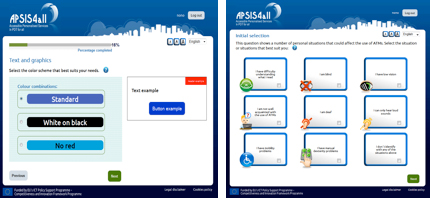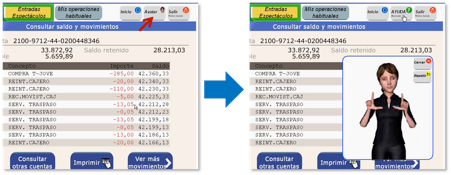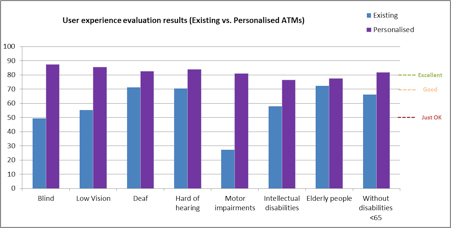It is increasingly difficult to ignore or avoid technology. In a “self-service” economy, the use of Public Digital Terminals (PDT) such as Automated Teller Machines (ATMs) for banking or Ticket Vending Machines (TVM) while traveling is often a necessity. As a result, those who cannot access and use these information technologies are increasingly at a distinct economic and social disadvantage
Accessibility Barriers in ATMs and TVMs.
Traditionally, ATMs and TVMs can present accessibility barriers to consumers. Users with visual disabilities may rely on audio output, but not all ATMs currently have this facility. Those ATMs that do incorporate some audio accessibility support rely on the user to activate those features using particular keypad combinations that are not consistent from one machine to another. Those with low-vision may require a larger text size. People with dyslexia may require a custom color combination in order to more easily read text on the screen. Additionally, older users may feel uncomfortable using information technology and shy away from using digital terminals for their transactions. At the moment, no solution has been developed to support these groups.
Survey Results of Barriers Experienced by Users
The complex nature of ATMs and TVMs, which often offer users an array of options delivered by any number of interface designs, can leave many users feeling overwhelmed. In our own 2011 survey of nearly 300 people in Spain and Germany, the existing digital terminals frequently presented a number of barriers to users, including:
- Difficulties handling cards and tickets and operating card slots
- Unclear interface design
- Differing user interfaces from terminal to terminal
- No options for customization of functionality
- No captioning of video or text transcript for audio information
- Lack of sign language content
- Limited voice output options
- Lack of graphics to increase understanding of text
- No alternative to touch screens or keypad
- Lack of clear text prompts or instructions to complete procedures
In our experience, and partially because of these barriers, people with disabilities often must rely on direct human interaction to ensure that their transactions are successful. Beyond the economic burden that this reliance implies for industry service providers, it impacts a person’s autonomy and their right to have equal access to basic services.
It is these barriers in particular that the APSIS4all (Accessible Personalized Services In Public Digital Terminals for all) consortium aims to overcome. Anyone can take advantage of the personalization features, but it is people with disabilities, linguistic difficulties, or low digital literacy skills that benefit most from the solutions.
Personalization to Create Accessibility
Led by Technosite in Spain, APSIS4all is a pan-European consortium of industry partners, research institutes, and organizations that represent disability groups. The goal of the APSIS4all project is to make digital terminals such as ATMs and TVMs more accessible and usable through personalization.
Vendors today are keen to push customers towards self service. The involvement of industry partners is key to the successful delivery of the APSIS4all solution. The Spanish bank la Caixa has installed 800 fully-accessible ATMs throughout Barcelona and Madrid. In Germany, TVM manufacturer Hoeft & Wessel has just deployed twenty-four machines used by the Padersprinter transport company in Paderborn. Up to 3,000 customers are expected to use them during the six-month pilot period that began in fall 2013.
From the outset of the project we have engaged directly with users to overcome some of the most frequently reported physical and psychological barriers to accessing digital terminals. APSIS4all addresses these barriers by allowing the user to configure the terminal so the display is simplified, or so that it displays only the options relevant to their needs.
APSIS4all not only focuses on overcoming accessibility barriers, but also on delivering an inclusive user experience by enabling digital terminals to adapt their interfaces automatically, according to an individual user’s needs and preferences. The project opens new methods of interaction with public terminals through the user’s smartphone and other mobile devices.
Direct and Indirect Interaction Approaches
APSIS4all implements two different approaches to an inclusive user experience via either “direct” or “indirect” interaction. The direct approach involves providing users with a contact or contactless smartcard that stores their needs and preferences (see Figure 1).
-

Figure 1. The direct interaction approach provides users with a contact or contactless smartcard that stores their needs and preferences.
The individual user accesses a web interface (see Figure 2) that allows them to identify their particular needs and preferences. The web interface guides them through a process to define and customize how a terminal presents their information. This information is stored using international standards, which facilitates the sharing with different service providers and systems. One relevant standard is EN 1332.

Once the users get to a terminal and present their card, the terminal changes the settings based on the stored information to suit their preferences, providing the most appropriate interface available. That way, public terminals automatically adapt to the individual user. Users can activate a range of personalized features such as changing the size of text, setting foreground and background colors, enabling audio output, adding sign language avatars (see Figure 3), or adding help content to support their interaction with the terminal.

The “indirect” approach shifts the personalization of the terminals to the Internet, so users can pre-set the tickets they will purchase from a TVM from any computer or smartphone. The user requests the desired service—for example, a bus ticket to Paderborn—and the system generates a unique identifier, such as a 2D-barcode or a security code, which is transmitted to the customer’s mobile phone. Finally, the user presents the 2D-barcode to the terminals’ barcode reader or they enter the security code in the terminal keypad to obtain their desired service (See Figure 4).

The key to the APSIS4all solution is simplicity; activating the personalized interface requires, at most, a minimal gesture such as touching a reader with a contactless smartcard or presenting a 2D-barcode. APSIS4all also foresees enabling and increasing multichannel interaction with the terminals using Near Field Communication-enabled (NFC) smartphones. This would dramatically increase the flexibility and convenience of the process for users. More importantly, it allows the industry service provider to engage directly with the user through a device that so many people, especially those with special needs, already own.
Industry Drive towards Personalization Services
Optimizing the user experience through personalization is a key strategy by industry service providers to engage customers and ensure that people of all needs have access to the current information technology encountered in their daily activities.
There is the increasing drive in the banking sector to optimize the use of ATMs for the most common services such as cash withdrawals. Banks also want to deliver a more diverse range of services through ATMs; services that customers would normally complete at a brick and mortar branch, such as passbook updates and pre-approved loans.
The reason behind this drive is to improve efficiency and cut costs. But if many users cannot, or are unwilling to, use the ATM in the first place, this drive could ultimately be in vain. Similarly, if passengers can use TVMs effectively, APSIS4all could make public transportation more appealing and increase frequency of use. This would both increase the independence of those with disabilities and reduce the operating costs of the service provider. With the increasing drive towards a self-service society, it is not difficult to envision the potential benefits of automated personalized services in other sectors such as e-government, healthcare, and leisure and entertainment.
Pilot Study of ATM Users Using Personalization
So what about the users? Initial results from a pilot study by users of la Caixa ATMs in Spain suggest that not only can users access the terminals, but the subsequent user experience is ultimately effective since they can achieve their desired action. In contrast, experience prior to the APSIS4all solution was, in some cases, unsuccessful.
During trials we measured a range of attributes, such as learnability, ease of use, and satisfaction, with 250 users across the range of user groups who will benefit from the APSIS4all solution. After collating the results, we compared the overall user experience of the traditional ATM interface with the interface users were presented with after completing the personalization tool.
As Figure 5 details, the user experience of existing ATMs for some user groups—particularly those with low or no vision, and those with motor disabilities—is particularly poor. However, by supporting personalization, the subsequent user experience of terminals improves for all groups, sometimes dramatically.

Optimizing the UX for All
We can see that personalization does lead to an enhanced user experience for users of the APSIS4all solution. As consumers increasingly expect personalization, perhaps the same will apply to a much broader demographic. The final results from the pilot programs will tell us more, but by empowering consumers, enabling increased access to services, and better control over how digital terminals deliver their functionality, service providers may find themselves becoming more desirable to new customers and gain a greater degree of loyalty from their existing clients.
There is a debate within the UX community (and society at large) on the impact of personalization and its effect on privacy. For the participants in the APSIS4all trial, no matter what country they came from, no matter what their specific requirements, personalization became a fundamental path to basic services of daily living.UX
Acknowledgement
APSIS4all is partially funded under the ICT Policy Support Programme (ICT PSP) as part of the European Commission’s Competitiveness and Innovation Framework Programme (CIP) by the European Community (2010-4 Project 270977). Duration: April 1, 2011 – March 31, 2014
This publication reflects only the author’s views and do not necessarily reflect the views of the European Commission. The European Community is not liable for any use that might be made of the information.
[bluebox]
More Reading
Learn more about international coalitions and initiatives of individuals and organizations working to ensure that the Internet, and everything available through it, is accessible to people experiencing barriers due to disability, literacy, or age.
- APSIS4all (Accessible Personalized Services In Public Digital Terminals for All)
- CLOUD4ALL
- GPII (Global Public Inclusive Infrastructure)
- RtF (Raising the Floor)
- SNAPI Project, Proposed revised version of EN 1332-4 Card Systems, Man-Machine Interface, Part 4: Coding of user requirements for people with special needs
- UN Convention on the Rights of Persons with Disabilities
Other articles in User Experience magazine about this topic include an early article about the Raising the Floor project, the original inspiration for Cloud4All, and the GPII.
- “A Call to Action for Universal Design from the United Nations” by Axel Leblois
- “People with Cognitive Disabilities: Variations in Assistive Technology” by Clayton Lewis
- “Raising the Floor” by Gregg Vanderheiden
[/bluebox]APSIS4all 项目(适用于所有人的可达的个性化公共数字终端服务)是由某个欧洲协作组织建立的,其目的是克服残障人士在使用自动柜员机和售票机时存在的访问障碍。 通过使用个性化服务,APSIS4all 让终端能够根据用户需求和偏好自动调整界面。 它还提供了通过智能手机等移动设备实现的各种新型交互模式。
文章全文为英文版현금자동지급기와 티켓 판매기를 사용할 때 사람들이 직면하는 기존의 접속 문제점을 극복하기 위해 유럽 컨소시엄이 APSIS4all 프로젝트(모든 사람들이 사용할 수 있는 공용 디지털 단말기의 맞춤형 서비스)를 마련하였습니다. 맞춤형 서비스를 사용함으로써, APSIS4all은 단말기들이 사용자의 요구와 선호에 따라 자동으로 인터페이스를 조절할 수 있게 합니다. 또한 스마트폰과 같은 모바일 기기를 사용하여 다양한 새로운 인터랙션 방식을 이용할 수 있게 합니다.
전체 기사는 영어로만 제공됩니다.O projeto APSIS4all (Serviços de Acessibilidade Personalizados nos Terminais Públicos Digitais para Todos) foi criado por um consórcio europeu para superar as barreiras de acessibilidade existentes que pessoas com deficiência enfrentam ao interagir com caixas eletrônicos e máquinas de venda de bilhetes. Utilizando serviços de personalização, o APSIS4all permite que os terminais adaptem suas interfaces automaticamente de acordo com as necessidades e preferências dos usuários. Ele também abre uma variedade de novos modos de interação através de dispositivos móveis, como smartphones.
O artigo completo está disponível somente em inglês.APSIS4all (Accessible Personalized Services In Public Digital Terminals for all:すべての人に公共デジタル端末を利用できるようにする個人化サービス) プロジェクトは、障害者を含む多くの人々がATMや切符販売機を操作する際に直面するアクセシビリティのバリアを克服するため、欧州共同事業体によって設立された。APSIS4allは、個人化されたサービスの使用により、ユーザーのニーズや好みに端末のインターフェースを自動的に適合させることができる。またスマートフォンをはじめとする様々な新しいインタラクションモードにも対応を拡大している。
原文は英語だけになりますEl proyecto APSIS4all (Accessible Personalized Services In Public Digital Terminals for all, Servicios personalizados y accesibles en terminales digitales públicas para todos) fue creado por un consorcio europeo para superar las barreras de accesibilidad existentes que enfrentan las personas con discapacidades cuando interactúan con cajeros automáticos y máquinas de venta de billetes. Mediante el uso de servicios de personalización, APSIS4all permite que los terminales adapten sus interfaces de manera automática según las necesidades y preferencias de los usuarios. También posibilita una gran variedad de nuevos modos de interacción usando dispositivos móviles, como los teléfonos inteligentes.
La versión completa de este artículo está sólo disponible en inglés
